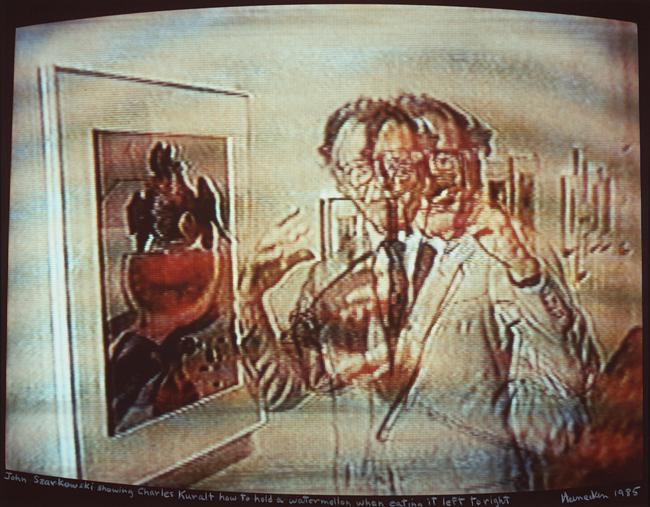Robert Heinecken
Robert Heinecken, John Szarkowski showing Charles Kuralt how to hold a watermelon when eating it left to right, 1985. Robert Heinecken Archive/Gift of the artist.
© The Robert Heinecken Trust and Pace MacGill Gallery. 93.68.54
Throughout his career, Robert Heinecken (1931–2006) amused, educated, and often shocked viewers with his pointed, irreverent photographic works. So provocative were Heinecken’s subjects—the Vietnam War, pornography, sexual politics, the media marketplace—that many critics and other observers rank either as avid fans or staunch detractors. It has always been difficult to call him a “photographer” in the strict sense of the word, because he rarely used a camera to make his pictures. Rather, Heinecken worked on the fringes of the photographic medium, and in the margins of what might be considered acceptable subject matter, as an artist who used photography only as a means to an artistic end.
Heinecken was born in Denver, Colorado, the only child of a Lutheran minister. In 1942 the family moved to Southern California, where Heinecken attended public high school and then community college in Riverside, earning an Associate’s Degree in Art in 1951. For the next two years, Heinecken studied at the University of California, Los Angeles. He dropped out in 1953 to enlist in the United States Navy, where he learned to fly airplanes. In 1954 he joined the Marine Corps as a fighter pilot. When he was discharged in 1957, he returned to university on the GI Bill, earning a BA in art in 1959 and an MA the following year. While in school, Heinecken concentrated mostly on printmaking, but by the end of his graduate study, he was introduced to photography and to the pre–Pop art ideas of Robert Rauschenberg and other artists who were using photographic imagery.
In 1960, Heinecken was appointed as an instructor in the Department of Art at UCLA, teaching drawing, design, and printmaking. Within two years he had initiated a photographic curriculum for the department and was appointed Assistant Professor in 1962, overseeing a regular series of courses in undergraduate photography. Over the next three decades, Heinecken’s influence as a teacher was profound; he encouraged his students to approach art—and particularly photography—in the same spirit of experimentation with which he approached his own work. Fostered in part by social and political events of the day—the Vietnam war, the women’s movement, and the growth of the counterculture—the classroom became a place for dialogue and self-evaluation.
When Heinecken emerged in the Southern California art scene in the mid-1960s, he was one of a growing number of artists who had begun to incorporate photographs and other images into their art as a way to renegotiate the nature and meaning of contemporary art. Other Los Angeles artists, like Ed Ruscha and John Baldessari, practiced photography as a medium of conceptual art. Inspired by these new approaches, Heinecken seized the opportunity to transform a medium restrained at one time by the purist principles of modernism into one increasingly intertwined with popular culture. At every stage, Heinecken’s work reminds us of photography’s pervasiveness and its significance as a medium of transformation. The Center’s first director, Harold Jones, acquired the first Heinecken prints for the collection in 1975. The formal arrival of the Robert Heinecken Archive began in 1981. It has now grown to over 90 boxes of archival materials and more than 500 artworks.


